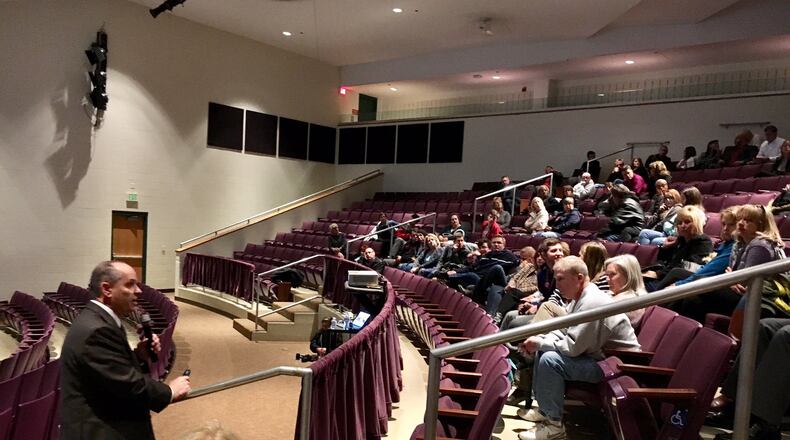The plan calls for directly involving students for the first time in “Hope Squads” because — as founder Dr. Greg Hudnall, a national champion for suicide prevention in schools told 80 Lakota school parents, students and officials Monday — nobody knows teens like teens.
“We’re often afraid to talk about suicide because we’re afraid it will give someone the idea,” Hudnall told the audience at Lakota East High School.
“The reality and research shows it is actually the opposite,” said the former Utah school district official, who founded Hope Squads that have since been adopted by many school districts in Southwest Ohio and nationwide.
In schools where Hope Squads have been formed, recent data analysis show that over 25 percent of all referrals to counselors have been from Hope Squad members. Of those referrals, 14 percent have been hospitalized for successful treatment, Hudnall told the audience.
The squads will consist of students specially trained to identify at-risk students, provide friendship and seek help from adults.
The “critical piece” of the Hope Squad strategy, he said, is the peer-to-peer component.
Hudnall shared a story about a Utah high school teen who came to school one day and gave his best friend his watch — a cherished family heirloom — and said he wouldn’t be needing it anymore. The friend was perplexed and didn’t have any formal adult contacts at school to turn to and share his concerns about his friend’s strange behavior. Shortly after, the boy killed himself.
“Of the people who commit suicide, 7 out of 10 will tell a friend, but the friend will never tell an adult,” he said.
According to the U.S. Centers for Disease Control and Prevention, suicide rates for adolescent boys and girls have been steadily rising since 2007.
And the problem is especially dangerous for teen girls, according to the center’s data, which shows the suicide rate for girls ages 15-19 doubled from 2007 to 2015, when it reached its highest point in 40 years.
The suicide rate for boys ages 15-19 increased by 30 percent over the same time period.
Both Lakota East and Lakota West high schools will have Hope Squads in place when classes start in August.
But Hudnall cautioned the positives of the new program “will not happen overnight.”
He said his group’s research shows “it takes two to three years to change a school culture.”
“We can’t prevent every suicide, but we can prevent many,” he said.
Lakota East junior Alyssa Longworth is eager to start her work as a member of the school’s first Hope Squad.
“Our family recently had a suicide. Suicide is a big problem, especially for my generation and I just want to do as much as I can to prevent it from happening,” said Longworth.
“I want everyone (classmates) to feel welcomed in the community and feeling happy. It’s great to have this program and be trained in what to do,” she said.
About the Author
